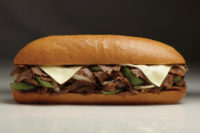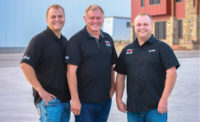Through 30 years of operation, every company is bound to have good years and bad years. Navigating the difficult times can be trying, but if done successfully, it can make the good years even better.
Over the course of its 30-year history, Busseto Foods has had to reinvent itself and go through several ownership changes. Eventually, the company was able to get the right people in place, and the management was able to steer the company into a profitable direction.
Busseto Foods, located in Fresno, Calif., produces a full line of deli and dry-cured salami, available in a variety of packaging options for the foodservice and retail industries. It also offers a full line of other Italian specialty meats, including prosciutto, coppa, bresaola and pancetta. Each is available in several varieties, from a hot coppa to prosciutto hand-rubbed with Herbes de Provence. The company is also releasing more and more value-added products, including meat-and-cheese trays and combo packages that feature several varieties of salami or an antipasto tray.
Busseto Foods sells its products throughout the United States, Canada, Japan, Puerto Rico and Mexico. The company has been on a particularly strong growth spurt within the last three years, raising its annual sales from about $20 million to $36 million. The company’s versatility has been a leading factor in its success.
“A lot of our products are geared toward catering and cruise ships,” explains Michael Grazier, president. “Foodservice is another key component of our business.”
Along with its branded lines, the company is also very active in private-labeling. Its best-selling natural product is a line of natural, antibiotic-free salami that it manufactures for a leading natural foods company. Grazier notes that while some companies don’t want to take on private-labeling, Busseto does it whenever it makes sense for the company.
“[The customer] is going to have their program whether or not we want to do it,” he says. “If you don’t want [private-labeling] you’re pretty much going to hand that business over to a competitor.”
Grazier notes that, although products such as salami have been a staple in the United States, other products have been slower to gain traction.
“In Europe, people know what to do with the product, because it’s been a part of their lives,” he said, adding that mainstream acceptance came from an unexpected source.
“Then along came the Food Network, where you’ve got a whole channel devoted to nothing but food. It’s done miracles for our industry, because it’s told people what to do with pancetta or prosciutto.”
Busseto’s evolution
Busseto Foods originally started off as Rapelli of California, a maker of very high-end, European-style salami. The original owner, who came from Switzerland, struggled with the business and ended up selling it to an Italian group. The group quickly expanded the company’s facility to 30,000 square feet, adding four fermentation rooms and two drying rooms. Unfortunately, with little product actually being produced, the losses accelerated, so the owners turned to an American manager. Grazier was hired in August 1991, coming to the company from the poultry industry. Although he was not a salami expert, he saw the state of the company and quickly worked to put out the worst of the fires.
“The production was only a couple-thousand pounds a week,” he explains. “They were aiming at a very upper niche of what I already considered a niche business. Losses were steep, morale was bad, and no one had ever been taught how to run a business.
“The plant manager was a vegetarian,” he adds, laughing.
Since the company had a nice facility, Grazier set out to change the production and begin manufacturing products that consumers would buy instead of the high-end niche products — such as Italian dried salami, prosciutto and pepperoni.
A big boost came when the Italian parent arranged to have a salami expert come stateside for a two-year project. Lorenzo Pagani, Busseto’s production technician started making salami in 1955 and worked for the same company in Italy for 36 years.
“I retired very young — around 50 years old, and I decided to learn some English,” he recalls. He knew of Busseto’s parent company and asked if they needed someone in the U.S. to work on salami. They quickly agreed to send him overseas on a two-year project.
“After two years, I still didn’t speak any English, so I had to stay longer,” says Pagani, who has now been with Busseto Foods for 20 years.
Grazier says that Pagani spent his first five or six years in the U.S. developing the company’s new product portfolio.
“He was savvy enough to say, ‘Show me the market. I know what people like in Italy, but I don’t know what American tastes are,’” Grazier explains. “He was willing to adapt his knowledge of how to do it in Italy to the American market.”
After an issue with the company’s
previous owners over the company name, the company was able to get a completely new start in 1996 with a new name, Busseto Foods. Busseto is the name of a village outside of Parma, where the parent company is headquartered. Grazier took advantage of the opportunity and went a step further than just inserting a new name on the old labels.
“We went to a graphic designer and redid our labels, our look,” he says. “Almost from that moment on, we took off and never looked back. We got into some private-label programs, and business really started picking up.”
Grazier also credits the company’s operation’s manager, Paul Gillum, for helping to take Busseto to the next level. Gillum, a graduate of California State University in Fresno, came on in 2001.
“Simply stated, we couldn’t be where we are, with these results, without Paul,” Grazier says. “I can’t overstate his worth to our company.”
Busseto Foods has kept the momentum going, adding a 45,000-square-foot distribution facility in 2001 and several plant expansions since then. The company recently added an additional 12,000 square feet of space, with six more drying rooms, a freezer, and a break room and changing room for the employees on the raw side of the business. It’s the fifth expansion in the last 10 years and brought the building’s size to 72,000 square feet.
Grazier notes that keeping up with trends in salami can be difficult, because the product takes so long to make. Production can be a six-week process, and if the taste is off and requires more work, that extends product development even further. However, Busseto has been able to respond to flavor and packaging trends to remain an innovative company.
The company’s ties back to Italy have been an asset in staying on the cutting edge. In 2007, Busseto was acquired by Fratelli Beretta, a company based in Milan, Italy, with almost 200 years of meat-processing history. Grazier says Busseto Foods is able to tap into Fratelli’s product development pipeline. For instance, Busseto will be releasing an Italian product called piadina, which is a flatbread with prosciutto and cheese inside that can be microwaved or grilled.
Oddly enough, Busseto is also going back to its roots as a high-end salami-maker.
“There’s a trend going on now for artisan-style salami,” Grazier points out. “We’re creating product lines now of very ethnic, old-style salamis. Slowing the fermentation process down, slowing the drying rooms way down, having a relatively high pH — really going back to the roots of salami production.”
Some of those latest artisan products are paper-wrapped and packaged to show off the particle definition in the salami, when that sort of product did not sell at all 20 years ago. Grazier notes that when the company introduced them at an International Dairy Deli Bakery Association trade show, many of the attendees asked if they were brought in from Italy.
“No, they brought me in from Italy to make it,” replies Pagani.
“It’s easier to bring Lorenzo in than the product,” Grazier adds.
Producing the artisan products can be a challenge, as they require more time in the drying room and can take away from the more commercial products. It’s a balancing process to satisfy both ends of the business. Grazier says that it would be difficult to rely on the artisan salami, but it nicely complements Busseto’s existing business.
The most recently added drying and fermentation rooms can hold three times as much product as the older rooms, but every room, regardless of age, is monitored 24 hours a day. Because the company produces so many products, each of which has its own variables, Pagani has created programs for each product. Furthermore, he monitors them and can make adjustments based on external temperatures, the temperature of the meat when stuffed, the load in the room or other variables.
“That’s really where the art and science meet,” Grazier says. IP









